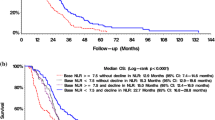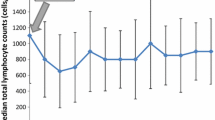Abstract
Patients with progressive glioblastoma (GBM) have a poor prognosis. Neutrophil/lymphocyte ratio (NLR), a host inflammatory marker, is prognostic in several solid tumors. The prognostic impact of either NLR, or time from first surgery for GBM to first progression (TTP), in patients undergoing second surgery, has not been assessed. Patients undergoing second surgery for GBM were retrospectively reviewed. Primary outcome was overall survival (OS) and Cox proportional hazard models were used to assess the prognostic value of baseline characteristics including TTP and NLR. Univariable and multivariable analysis (MVA) of OS from second surgery were performed using accelerated failure time Weibull model. Of 584 patients with GBM, 107 (18 %) underwent second surgery between 01/04 and 12/11. Patients who underwent second surgery had longer OS versus those having primary surgery alone; 20.9 versus 9.9 months (P < 0.001). Median OS from second surgery in patients with NLR ≤ 4 versus NLR > 4 was 9.7 versus 5.9 months (log rank P = 0.02). The NLR retained its prognostic significance for survival on MVA (time ratio [TR] 1.65, 95 % confidence interval [CI] 1.15–2.35, P < 0.01). No chemotherapy post second surgery (TR 0.23, 95 % CI 0.16–0.33, P < 0.001) portended worse survival. In patients undergoing second surgery, when TTP was ≤12 months, 12–24 months, or >24 months, median OS from second surgery was 7.2, 7.0 and 6.3 months, respectively (P = 0.6). A NLR > 4 prior to second surgery is a poor prognostic factor in GBM and later progression is associated with longer survival in patients but not in longer survival after second surgery.

Similar content being viewed by others
References
Stupp R, Mason WP, van den Bent MJ et al (2005) Radiotherapy plus concomitant and adjuvant temozolomide for glioblastoma. N Engl J Med 352:987–996
Ammirati M, Galicich JH, Arbit E, Liao Y (1987) Reoperation in the treatment of recurrent intracranial malignant gliomas. Neurosurgery 21:607–614
Barker FG, Chang SM, Gutin PH et al (1998) Survival and functional status after resection of recurrent glioblastoma multiforme. Neurosurgery 42:709–720
Dirks GR, Bernstein M, Muller PJ, Tucker WS (1993) The value of reoperation for recurrent glioblastoma. Can J Surg 36:271–275
Harsh GR, Levin VA, Gutin PH et al (1987) Reoperation for recurrent glioblastoma and anaplastic astrocytoma. Neurosurgery 21:615–621
Proctor MJ, Morrison DS, Talwar D et al (2011) A comparison of inflammation-based prognostic scores in patients with cancer. A Glasgow inflammation outcome study. Eur J Cancer 47:2633–2641
Templeton AJ, McNamara MG, Vera-Badillo et al (2013) Prognostic role of neutrophil to lymphocyte ratio (nlr) in solid tumors: a systematic review and meta-analysis. Eur J Cancer 47: (Suppl 1, abstract 1008)
Guthrie GJ, Charles KA, Roxburgh CS, Horgan PG, McMillan DC, Clarke SJ (2013) The systemic inflammation-based neutrophil–lymphocyte ratio: experience in patients with cancer. Crit Rev Oncol Hematol 88:218–230
Petrie HT, Klassen LW, Kay HD (1985) Inhibition of human cytotoxic T lymphocyte activity in vitro by autologous peripheral blood granulocytes. J Immunol 134:230–234
El-Hag A, Clark RA (1987) Immunosuppression by activated human neutrophils. Dependence on the myeloperoxidase system. J Immunol 139:2406–2413
McCourt M, Wang JH, Sookhai S, Redmond HP (1999) Proinflammatory mediators stimulate neutrophil-directed angiogenesis. Arch Surg 134:1325–1331
Di Carlo E, Forni G, Musiani P (2003) Neutrophils in the antitumoral immune response. Chem Immunol Allergy 83:182–203
McCourt M, Wang JH, Sookhai S, Redmond HP (2001) Activated human neutrophils release hepatocyte growth factor/scatter factor. Eur J Surg Oncol 27:396–403
Jablonska E, Kiluk M, Markiewicz W, Piotrowski L, Grabowska Z, Jablonski J (2001) TNF-alpha, IL-6 and their soluble receptor serum levels and secretion by neutrophils in cancer patients. Arch Immunol Ther Exp (Warsz) 49:63–69
Schaider H, Oka M, Bogenrieder T et al (2003) Differential response of primary and metastatic melanomas to neutrophils attracted by IL-8. Int J Cancer 103:335–343
Shamamian P, Schwartz JD, Pocock BJ et al (2001) Activation of progelatinase A (MMP-2) by neutrophil elastase, cathepsin G, and proteinase-3: a role for inflammatory cells in tumor invasion and angiogenesis. J Cell Physiol 189:197–206
Scapini P, Nesi L, Morini M et al (2002) Generation of biologically active angiostatin kringle 1-3 by activated human neutrophils. J Immunol 168:5798–5804
Bambury RM, Teo MY, Power DG et al (2013) The association of pre-treatment neutrophil to lymphocyte ratio with overall survival in patients with glioblastoma multiforme. J Neurooncol 114:149–154
Polley MY, Lamborn KR, Chang SM et al (2010) Six-month progression-free survival as an alternative primary efficacy endpoint to overall survival in newly diagnosed glioblastoma patients receiving temozolomide. Neuro Oncol 12:274–282
Hosmer DW, Lemeshow S, May S (2008) Applied survival analysis: regression modeling of time to event data. Wiley, New York
Gondo T, Nakashima J, Ohno Y et al (2012) Prognostic value of neutrophil-to-lymphocyte ratio and establishment of novel preoperative risk stratification model in bladder cancer patients treated with radical cystectomy. Urology 79:1085–1091
Helseth R, Helseth E, Johannesen TB et al (2010) Overall survival, prognostic factors, and repeated surgery in a consecutive series of 516 patients with glioblastoma multiforme. Acta Neurol Scand 122:159–167
Terasaki M, Ogo E, Fukushima S et al (2007) Impact of combination therapy with repeat surgery and temozolomide for recurrent or progressive glioblastoma multiforme: a prospective trial. Surg Neurol 68:250–254
Yovino S, Grossman SA (2012) Severity, etiology and possible consequences of treatment-related lymphopenia in patients with newly diagnosed high-grade gliomas. CNS Oncol 1:149–154
Cedres S, Torrejon D, Martinez A et al (2012) Neutrophil to lymphocyte ratio (NLR) as an indicator of poor prognosis in stage IV non-small cell lung cancer. Clin Transl Oncol 14:864–869
Kao SC, Pavlakis N, Harvie R et al (2010) High blood neutrophil-to-lymphocyte ratio is an indicator of poor prognosis in malignant mesothelioma patients undergoing systemic therapy. Clin Cancer Res 16:5805–5813
Brandes AA, Franceschi E, Tosoni A et al (2010) O6-Methylguanine DNA-methyltransferase methylation status can change between first surgery for newly diagnosed glioblastoma and second surgery for recurrence: clinical implications. Neuro Oncol 12:283–288
Park JK, Hodges T, Arko L et al (2010) Scale to predict survival after surgery for recurrent glioblastoma multiforme. J Clin Oncol 28:3838–3843
Grossman SA, Ye X, Lesser G et al (2011) Immunosuppression in patients with high-grade gliomas treated with radiation and temozolomide. Clin Cancer Res 17:5473–5480
Carro MS, Lim WK, Alvarez MJ et al (2010) The transcriptional network for mesenchymal transformation of brain tumours. Nature 463:318–325
Acknowledgments
We thank Princess Margaret Cancer Centre Cancer Registry. Dr. Mairéad G. McNamara is funded by the Princess Margaret Cancer Centre clinical fellowship fund.
Conflict of interest
Warren P. Mason has served as an advisor for Roche. All other authors have no funding to declare.
Author information
Authors and Affiliations
Corresponding author
Rights and permissions
About this article
Cite this article
McNamara, M.G., Lwin, Z., Jiang, H. et al. Factors impacting survival following second surgery in patients with glioblastoma in the temozolomide treatment era, incorporating neutrophil/lymphocyte ratio and time to first progression. J Neurooncol 117, 147–152 (2014). https://doi.org/10.1007/s11060-014-1366-9
Received:
Accepted:
Published:
Issue Date:
DOI: https://doi.org/10.1007/s11060-014-1366-9




